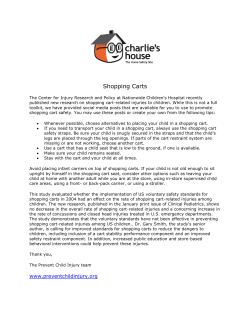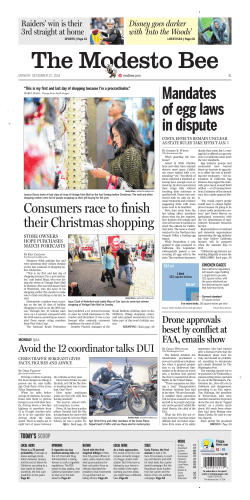
Why do all shopping malls look the same?
T +31 20 6257679 consultancy@carevolution.nl www.carevolution.nl Why do all shopping malls look the same? Did you notice; most shopping malls and high streets look alike. The same brands, stores, storefronts, design, people etc. What is the odd change, if two different retail developers and their respective architects, create two shopping malls, that they look the same? One-in-a-thousand? And still, they look the same! Some people say who cares, because most people will shop in a radius of action of about 20 Km in densely populated areas, like for example the cities in Europe. Who should know better how to solve this issue and many other retail issues as the members of ICSC, which held its annual conference last week in Amsterdam? The International Council of Shopping Centres (ICSC; founded in 1957) is the global trade association of the shopping center industry. Its 70,000 members in the U.S., Canada and more than 80 other countries include shopping center owners, developers, managers, marketing specialists, investors, lenders, retailers and other professionals. This conference shed light on sustainability in development and re-development of shopping malls and high streets. Zero CO2 Emission buildings and shops are important for our future and indeed retailers can make a statement by choosing for low emission shops. Go Zero or go Green will eventually also hit our shopping experience. And rightfully we have to invest now in new developments of the future. Still this doesn’t answer our main question; how can we continue to make shopping fun, exciting and different; a true experience? © Copyright 2008 Carevolution page 1 Rapenburgerplein 71 | 1011 VJ Amsterdam | The Netherlands VAT Nr: NL044522794B01 | general conditions OOA | www.carevolution.nl 22-Apr-08 Well now we have to start looking outside-in. According to John Kay; retailing exists to solve three problems: product search and selection purchasing delivery logistics. Half of the consumer expenditure is spend on retailing and the other half on: housing, utilities, financial products, petrol, services, car maintenance, leisure etc. However retailing, from a customer point of view, can be divided in shopping needs, wants and desires. Today’s needs are obvious for most consumers and the scheduled, often bulky, purchases we find close to home or within the near proximity, if there is a perceived price advantage. Often the car costs and time costs are not compared to the net financial benefit; hence perceived price advantage. Search, selection, purchasing and delivery should be easy, close and fast. A convenience store, like Wal*Mart will do. Wants supersedes the Maslow basic or physiological needs, such as: food, warmth, sex, water, and other body needs. Wants would be an item we would like to purchase as part of our shopping experience. We don’t need summer clothes, because last year’s will do fine. We want to look fashionably; hence we shop before the summer arrives. Retailing in malls and high streets is essentially about product browsing (search & selection), personal buying (purchasing) and gift wrapping (delivery). Desires; the ultimate shopping experience. Personal selling and point of sale communications are as important as creating the right mood. The Apple stores with its bright design, funky products and expert staff really make people drift towards a (impulse) purchase. Louis Vuitton, Kiko Milano, Dolce & Gabbana look like heaven to some of us. The Nespresso and Rituals shops are beyond coffee and soap. Looking outside-in and breaking with the current retail laws will be the only solution for developers to be distinctive in their offering. Generate great ideas, create the right mood, elect your tenants, communicate with your audience and work as a team to enchant the consumer. Get rid of the Chinese walls in your shopping property. Caution an example of eroding retailing, we find all over the US. In early 2005, husband-and-wife filmmaking team Hanson Hosein and Heather Hughes spent 52 days driving 13,000 miles through 32 states with a video camera. Their mission: to document how mom-and-pop independents were faring, faced with fierce © Copyright 2008 Carevolution page 2 Rapenburgerplein 71 | 1011 VJ Amsterdam | The Netherlands VAT Nr: NL044522794B01 | general conditions OOA | www.carevolution.nl 22-Apr-08 competition from big-box retailers, as well as how small communities were changing across America. They set rules for their trip, which included only shopping, and eating at independent establishments and avoiding interstate highways. The result is their video documentary; ‘Independent America’, which came out in November, 2005. To view a trailer of the film, go to Independent America. Author: Christian ter Maat MCC, MMC, CMC; Director Carevolution; management and organisation consultants. We are strategy, organisation, management and communication consultants with a curiosity for nearly any industry and a passion for: media, entertainment, creative industries, hospitality, leisure, tourism, retail, wellness, care, charity, professional services, real-estate and automotive. © Copyright 2008 Carevolution © Copyright 2008 Carevolution page 3 Rapenburgerplein 71 | 1011 VJ Amsterdam | The Netherlands VAT Nr: NL044522794B01 | general conditions OOA | www.carevolution.nl 22-Apr-08
© Copyright 2025





















